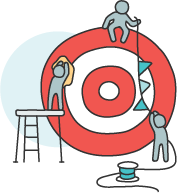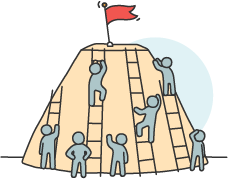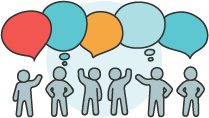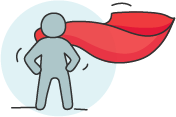Below is the third installment in our series, The Power of Immersive Experience, in which we explore the key aspects of immersive experiences with the goal of understanding how they relate to building collective intent and spurring organizational change.
Organizational leaders know how incredibly difficult it can be to design meetings and events that harness and direct the attention of participants in a sustained manner. But focus and flow are critically important to achieving exceptional outcomes (as discussed in our series opening). After decades of crafting and facilitating collaborative design sessions, we’ve found that the following six strategies consistently produce game-changing levels of directed attention. These strategies aren’t about extravagance or shock and awe; they’re about adhering to a clear set of principles and keeping the living-breathing humanity of your participants in the forefront of your mind, in service of creating better shared experiences and solutions.
 1: Let the Objectives Reign Supreme
1: Let the Objectives Reign Supreme
Ensure that any gathering (meeting, retreat, conference, workshop, etc.) centers on a clear set of objectives. Commit time upfront to honing these objectives and be sure to get buy-in from the top-level sponsors and organizers. Once agreed upon, let the objectives guide the planning process. In other words, ruthlessly eliminate all items from the agenda that do not directly serve these ends. Share the objectives with the participants beforehand; read them aloud as part of the kick-off to your event; post them in a large-scale format for the duration of the gathering; and reference them as a means of keeping everyone on track and demonstrating progress.
 2: Share Your Objectives, Not Your Detailed Agenda
2: Share Your Objectives, Not Your Detailed Agenda
Skeptical? We know. We were once skeptical too. But after decades of experience, we’re convinced it is best not to distribute a detailed agenda with your participants. Think about it. Your goal is to keep people fully present in the moment. The way to achieve this is to instill the participants with a sense of confidence that their time will be well used, while not distracting them with the “how.” Share the objectives for the gathering with a high-level roadmap of how you will get there, but don’t get into the timing and logistics of each activity. Afraid of pushback from participants? An easy response: “We have a detailed agenda, but we want to allow for real time adjustments in response to the needs of the group.”
 3: Take the Group on a Journey
3: Take the Group on a Journey
When designing your detailed agenda, make sure that each activity builds on the next. If you could easily swap out one exercise or agenda section for the next, that’s a sure sign this isn’t happening. The best way to get people to focus is to convince them that they can’t miss a step. If the knowledge, experiences, and relationships established in one activity keep evolving and paying off, people will want to stay engaged.
 4: Make it Personal
4: Make it Personal
Find opportunities to get people talking and sharing early on in the event. This builds community and allows you to get a sense of where people are coming from. Go beyond traditional icebreakers! Invite people to share something meaningful about themselves as it relates to the meeting/event objectives. Make sure the design of your event allows you to take this input and use it in a meaningful way to inform the conversation going forward. For example, kick-off with an activity that allows each participant time to document his/her vision of the future and to share it in small groups. Find opportunities to thread the key themes that emerge into future dialogues.
 5: Manage the Energy
5: Manage the Energy
People need opportunities to actively engage and shape the experience. Challenge yourself to eliminate as many moments of “sit and get” as possible. At the very least, keep such moments short and sweet! Time box yourself: too much time for any given activity is a sure way to dissipate energy and momentum. Design exercises that allow enough time to extract the most valuable rather than the most comprehensive set of insights and experiences. Give people time checks to keep things moving. And never forget the importance of food and fun to keep energy up.
 6: Let Participants Take Matters Into Their Own Hands
6: Let Participants Take Matters Into Their Own Hands
Design your event to facilitate self-direction and active engagement (rather than passive). The more people can determine the course of events the more sense of ownership they will have over the outcome and thus the more focused they will remain. For example, when conducting a workshop focused on developing a course of action, allow people to sign-up for the working group they feel most passionate about. Similarly, if your participants engage in team activities, have them report back their learnings or experiences with the larger group.
Of course, it goes without saying that silencing cell phones and closing laptops will have a big impact as well. Give these strategies a try for your next event and see what kinds enhanced levels of directed attention you can achieve. We welcome you to share your experiences with us!
Back



